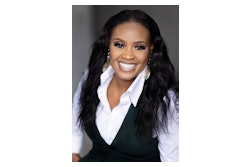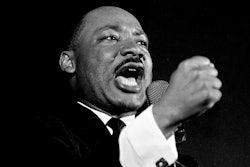When Aaron Hatchett arrived at The Ohio State University as a freshman in the fall of 2006, he wasn’t sure what the future held for him. The nation’s largest campus was daunting. Hatchett had no idea how he was going to pay for his education or what career he would pursue. He just knew he wanted to obtain a degree and make a better life for himself.
Now, nearly four years later, Hatchett is preparing to graduate with a degree in psychology and comparative cultural studies and with a minor in public policy. He plans to go to graduate school for education and social policy with the goal of working for the Department of Education in its social welfare program.
Hatchett credits the programs and staff at the Todd Anthony Bell National Resource Center for the African American Male at OSU for guiding and motivating him to focus and find academic success. The center first contacted him before his freshman year and invited him to attend its Early Arrival program, which it designed to acclimate African-American males to OSU. (African-American males comprise 6.2 percent of the school’s population.)
“The Early Arrival program was one of the most influential moments of my life,” says Hatchett. “The resource center takes anxiety away from being a student. The center staff gave me then, and continued to give me, resources going forward, so that I could have a life and focus on being a student, knowing that, for any issue or problem I had in the future, they would be there to talk to about it and help me through it.”
The Bell Resource Center is just one of several initiatives that help African-American men succeed in Ohio. All the programs focus on individual needs, individual achievement, positive role modeling and the acquisition of leadership skills.
The center was founded in 2004 as the African-American Resource Center out of a growing concern over the retention rate of Black male students at OSU, which was well below that of the general student population. Bell, a former All-American defensive back at OSU, had a “deep concern for the plight of African-American males,” says the center’s director, Dr. James L. Moore III.
Bell worked in the Office of Minority Affairs after his pro football career and saw a growing need to provide a stronger support network for Black males at OSU. After Bell’s death from heart disease in 2005, the center was named after him.
Since the center’s founding, the retention rate of Black male students has risen considerably. In 2003, the year before the center was formed, the retention rate for Black males at the Columbus campus was 80.7 percent. In 2008, the retention rate reached 89.3 percent, on par with that of OSU’s general student population at 92.8 percent.
“I would argue that we have one of the highest retention rates for a public institution in the country among African-American males,” says Moore. “Too often students feel like a number. We created an inviting environment.”
“We are constantly trying to connect students with luminaries in the community and on campus and provide ongoing professional development and supplemental experiences designed to help students obtain internships and personal networks for the future.”
Says DeWayne Williams, a fourth-year psychology major with a minor in neuroscience, “The programs at the center have taught me so many things, such as what a Black man should really be like, as well as motivated me to keep pushing myself academically, so I can be successful in the future. My experience with the center made me believe that I could achieve my goals and gave me that mindset to achieve.”
The center presents networking and educational programs throughout the year, including the Gathering of Men, where Black faculty, staff and students gather to hear presentations by guest speakers, and the African-American Male Retreat, where students attend research workshops on such topics as time management and financial management. It is an opportunity for the students to share information, build new relationships and skills and further develop critical thinking skills.
There is also the Leadership Institute, where students attend a series of programs designed to improve their leadership skills. This past fall, the center initiated the Bell Doctoral Fellows Program for graduate students to research topics related to African-American males.
Under the direction of Moore, who took the helm in mid-2008, the center has expanded its focus to research policy evaluation.
“It is important to emphasize the significance of the center,” says Moore. “We are the only center in America that focuses on African-American males that is housed at a major research institution.”
Helping Hands
In addition to the Todd Anthony Bell Resource Center, other entities in Ohio are trying to improve the educational status of Black males.
Ohio Board of Regents Chancellor Eric Fingerhut is leading discussions to develop a leadership center that focuses on Black achievement at the collegiate level. Fingerhut says concern over the college graduation rates in Ohio of African-American males, based on data collected from the Higher Education Database of Ohio, led to the discussions. Statistics from a study by the Ohio Board of Regents revealed that the six-year graduation rates for the cohort of Black male freshmen who started college in the fall of 2002 ranged from 5 percent at the University of Akron to 47 percent at The Ohio State University.
“In studying the data available to us, it occurred to us that we needed a centralized center that studied the best practices in helping African-American males graduate and advocated for the best practices across the university system,” says Fingerhut.
Fingerhut assembled a team of scholars, business executives and governmental leaders from across Ohio to discuss the issue. They’ve learned there are two key strategies to improve Black graduation rates. The first is to do early preparation for college.
“Not just academic prep, but the mentorship and support for applying for college,” says Fingerhut.
Second is an in-depth mentorship system for students once they are on campus so they have a support network to help them succeed.
Fingerhut’s vision is a center that helps schools in Ohio’s public university system develop programs to improve African-American male graduation rates at their respective universities.
The formal concern for college retention and graduation rates among Black males in Ohio dates from 1989, when Gov. Richard Celeste signed Executive Order 89-9 to form the Commission on Socially Disadvantaged Black Males, now known as the Ohio Commission on African American Males. The commission targets Black males before they reach college age through community outreach programs that focus on middle and high school students.
“The commission is focused on providing supplemental approaches to education,” says commission director Sam Gresham.
One such program the commission is developing is the school- and community-based Thinking Center. Starting in September, it will teach students how to study, take notes, complete tests and strengthen critical-thinking skills.
“We believe these are the key elements of educational achievement. A lot of Black males are never taught these skills,” says Gresham.
Another program starting this fall is the Leadership Program. The goal of the program is to “show young people the traits, characteristics and behaviors of leaders, how they do their work and what their values are,” says Gresham. As a precursor to this, says Gresham, two educational programs have been developed. The Discussion of Manhood, which began last month, profiles Black leaders. The other program is called Three Keys to Exploring Martin Luther King: Passions, Views, Approaches. It incorporates video, expert testimony and PowerPoint presentations to offer in-depth discussions of topics pertaining to Dr. King. The programs are in five Ohio communities and there are plans to expand. They offer youth insight into their self images and positive role models to improve their ability to make decisions for themselves.
“What we are trying to do in each one of these communities is build functioning, operating coalitions that identify problems of African-American males and begin to address these problems and find ways to resolve them,” says Gresham.
The Ohio Governor’s Closing the Achievement Gap is another initiative that targets African-American males before college age. In 2007, Gov. Ted Strickland approved $20 million for a two-year period to address the issue of improving high school graduation rates among Black males. According to Dr. Venita Kelley, the director of the program, in 2009 the initiative became legislated into law as part of an education reform approach.
One of the key actions of the initiative is placing a linkage coordinator in targeted schools. This person works with students on a one-on-one basis, addressing academic, social and emotional concerns. The linkage coordinator gets information about the student from teachers and administrative staff at the school and uses this information to provide the student with the support and encouragement that he needs to succeed in school. The program is focused on ninth-grade males. At-risk students are targeted by four key factors, according to Kelley: whether they are above age for their grade; their number of suspensions; their number of absences; and whether they have passed proficiency tests.
At present, the initiative is working on expanding into new school districts, going from 13 to 22 districts.
“We work with the superintendents, the principals and teachers,” says Kelley. “It’s a group effort to make this a success.”
But why does Ohio have so many wide-ranging initiatives for African-American males? Why would OSU invest in a center that focuses on African-American males? Why would the governor spend $20 million on an initiative that focuses on African-American males? Why is Ohio the first state to have a commission specifically focused on African-American males? Moore believes he has the answer.
“When the young people are not doing well in education, they cost this state billions of dollars to support other subsidies and the criminal justice system,” Moore says.


















